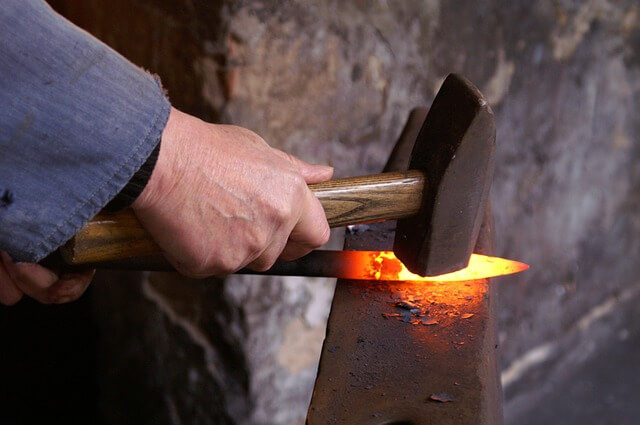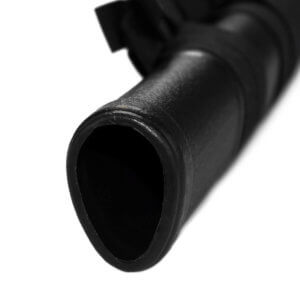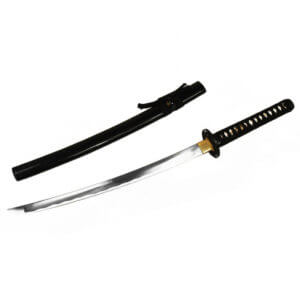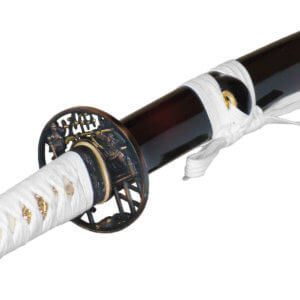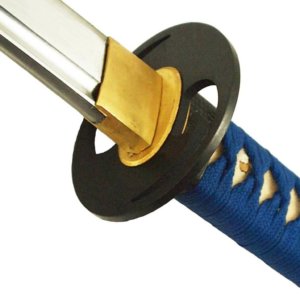A short video about some steel grades
Click here to view the content of YouTube.
Learn more in YouTube’s privacy policy.
There is a whole range of steel grades for swords. It is sometimes difficult to keep an overview, especially as there are colloquial names, names according to the American standard, names according to the German standard and names according to the EU standard for many types of steel.
For this reason, we provide you with a table below, which you can use to identify the most common types of steel for samurai swords and also find out the composition of the respective steel.
You will not find in this table Damascus steel and Tamahagane steelboth of which are often used for samurai swords.
Damascus steel can consist of all kinds of steel grades. It is called Damascus steel because of its characteristic pattern, but the composition can vary greatly.
Tamahagane steel is the traditional steel for samurai swords and varies in composition due to the manufacturing method.
There are groups of different steels for the manufacture of swords. This is why you hear these names more often. The most important groups are
Carbon steel
A type of steel with few alloying elements other than carbon. The steel is used in industry. It is therefore produced in large quantities and is comparatively cheap and fortunately also suitable for the production of swords. The carbon content can be determined almost freely using modern production methods.
Spring steel
Is a designation for steel grades from which springs are produced. This also includes some steel grades from the aforementioned carbon steel category. For the production of springs, the steel must have the property of returning to its original shape as far as possible after deformation.
This is why this steel is often used for swords for cutting tests, as the blade can quickly bend if the cutting tests are not carried out properly, which happens less often with this steel.
Stainless steel
Steel that is highly resistant to rust. This requires a high chromium content. This prevents the formation of rust. However, it also ensures that the blade cannot be ground as sharp as with other types of steel. Due to its easy handling, this steel is often used for decorative swords.
Info: How do you decipher steel names like 125Cr2?
Such designations always start with the carbon content of the steel in per cent by mass times 100. 125CR2, the carbon content is therefore 125 / 100 = 1.25 per cent by mass.
The chemical symbols of the alloying elements contained follow in descending order with regard to their mass fractions. In the example 125Cr2 contains Cr. The steel therefore contains chromium.
At the end are the respective mass fractions in the same order as the alloying elements listed above.
If several alloying elements are mentioned, the individual values of the mass fractions are separated from each other by a hyphen or a mass number is only given for the alloying element with the highest content. To calculate the actual content, the mass fractions must be divided by the following numbers:
1000: Boron (B)
100: Carbon (C), nitrogen (N), phosphorus (P), sulphur (S), cerium (Ce)
10: Aluminium (Al), curium (Cu), molybdenum (Mo), titanium (Ti), vanadium (V), beryllium (Be), tantalum (Ta), zirconium (Zr), niobium (Nb), lead (Pb)
4: Chromium (Cr), cobalt (Co), manganese (Mn), nickel (Ni), silicon (Si), tungsten (W)
In our example 125Cr2 this means that 2 must be divided by the number 4 to determine the proportion: 2/4 = 0.5 per cent by mass
Accordingly, this steel grade contains 0.5% chromium.
Summary: Our example 125Cr2 is therefore a steel with 1.25% carbon and 0.5% chromium.
Additional information: Labelling of high-alloy steels
High-alloy steels are characterised by an average mass content of at least one alloying element with more than 5%. Their steel names are labelled with a large X is placed in front. This is followed by the carbon content multiplied by a factor of 100 and the element symbols of the alloying elements contained. At the end are the percentage mass fractions of the alloying elements. In the case of high-alloy steels, these do not need to be converted further!
Example: X46Cr13
This is a high-alloy steel with a carbon content of 0.46% and a chromium content of 13%.
Common blade steel in the different steel standards in the steel table
| Designation | Material | AISI | Name | DIN standard |
| 1045 Carbon steel | 1.0503 | 1045 | C45 | 10083-2 |
| 1055 Carbon steel | 1.0535 | 1055 | C55 | 10083-2 |
| 1060 Carbon steel | 1.0601 | 1060 | C60 | 10083-2 |
| 1067 Carbon steel | 1.0603 | 1070 | C67 | 10132-4 |
| 1075 Carbon steel | 1.0605 | 1075 | C75 | 10132-4 |
| 1095 Carbon steel | 1.1274 | 1095 | C100 | 10083-2 |
| 51CrV4 | 1.8159 | 6150 | 51CrV4 | 10132-4 |
| 125Cr2 | 1.2002 | - | 125Cr2 | 10132-4 |
| 5160 | 1.7176 | 5160 | 55Cr3 | 10089 |
| 420 | 1.4034 | 420 | X46Cr13 | 10088-3 |
| 440A | 1.4109 | 440A | X70CrMo15 | |
| 440B | 1.4112 | 440B | X90CrMoV18 | 10088 |
| 440C | 1.4125 | 440C | X105CrMo17 | |
| L6 Bainite | 1.2714 | L6 | 55NiCrMoV7 |
Steel composition for the most common types of steel for samurai swords:
| Designation | C% | Mn% | Si% | P% | S% | Cr% | Ni% | Cu% | ||
| 1045 Carbon steel | 0,42 - 0,50 | 0,50 - 0,80 | ≤ 0,40 | 0,03 | 0,035 | ≤ 0,40 | ≤ 0,40 | ≤ 0,10 | ||
| 1055 Carbon steel | 0,52 - 0,60 | 0,60 - 0,90 | ≤ 0,40 | 0,035 | 0,035 | ≤ 0,40 | ≤ 0,40 | ≤ 0,10 | ||
| 1060 Carbon steel | 0,57 - 0,65 | 0,60 - 0,90 | ≤ 0,40 | 0,045 | 0,045 | ≤ 0,40 | ≤ 0,40 | ≤ 0,10 | ||
| T-10 | 0,95 - 1,04 | ≤ 0,40 | ≤ 0,30 | 0,035 | ≤ 0.030 | |||||
| 1067 Carbon steel | 0,65 - 0,72 | 0,60 - 0,90 | 0,15 - 0,35 | 0,045 | 0,045 | |||||
| 1075 Carbon steel | 0,70 - 0,80 | 0,60 - 0,80 | 0,15 - 0,35 | 0,045 | 0,045 | |||||
| 1095 Carbon steel | 0,95 - 1,05 | 0,30 - 0,60 | 0,15 - 0,35 | 0,025 | 0,025 | ≤ 0,40 | ≤ 0,40 | ≤ 0,10 | ||
| Designation | C% | Mn% | Si% | P% | S% | Cr% | Ni% | Cu% | Mo% | V% |
| 51CrV4 | 0,47 - 0,55 | 0,70 - 1,10 | ≤ 0,40 | 0,025 | 0,025 | 0,90 - 1,20 | 0,10 - 0,25 | 0,4 | ||
| 125Cr2 | 1,20 - 1,30 | 0,25 - 0,40 | 0,15 - 0,35 | 0,025 | 0,025 | 0,40 - 0,60 | 0,4 | ≤ 0,10 | ||
| 5160 | 0,52 - 0,59 | 0,70 - 1,00 | ≤ 0,40 | 0,025 | 0,025 | 0,70 - 1,00 | ||||
| 420 | 0,43 - 0,50 | ≤ 1,00 | ≤ 1,00 | 0,04 | 0,015 | 12,5 - 14,5 | ||||
| 440A | 0,60 - 0,75 | ≤ 1,00 | ≤ 0,70 | 0,04 | 0,015 | 14,0 - 16,0 | 0,40 - 0,80 | |||
| 440B | 0,85 - 0,95 | ≤ 1,00 | ≤ 1,00 | 0,04 | 0,015 | 17,0 - 19,0 | 0,90 - 1,30 | 0,07 - 0,12 | ||
| 440C | 0,95 - 1,20 | ≤ 1,00 | ≤ 1,00 | 0,04 | 0,015 | 16,0 - 18,0 | 0,40 - 0,80 | |||
| L6 steel | 0,50 - 0,60 | 0,60 - 0,90 | 0,10 - 0,40 | 0,03 | 0,03 | 0,80 - 1,20 | 1,50 - 1,80 | 0,35 - 0,55 | 0,05 - 0,15 |

